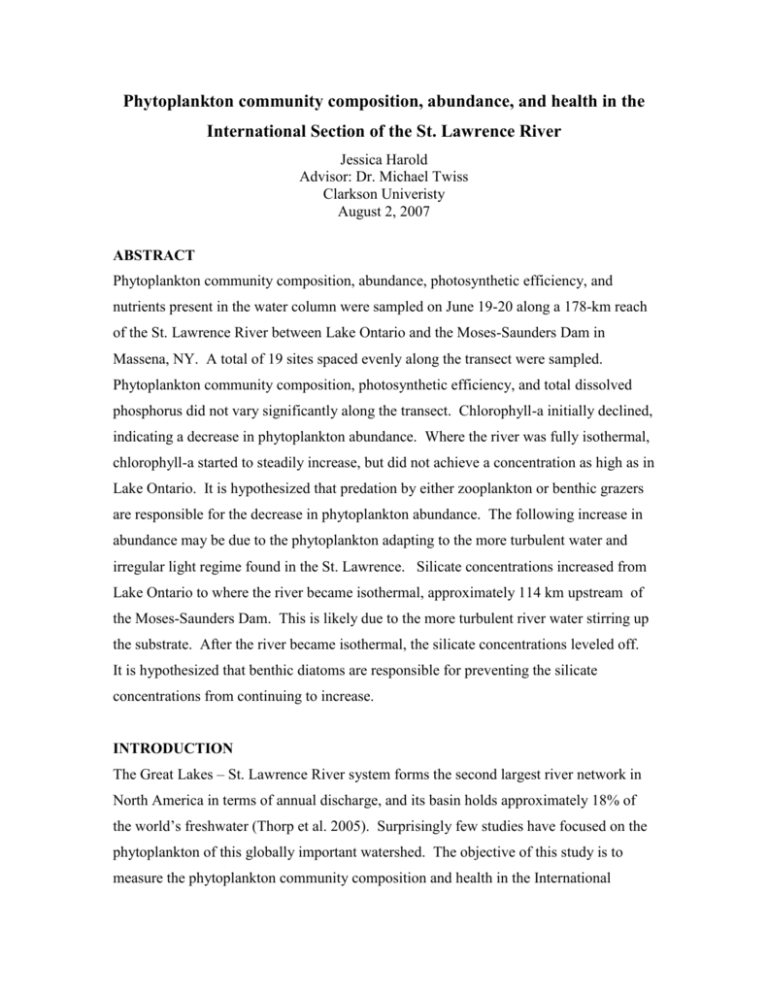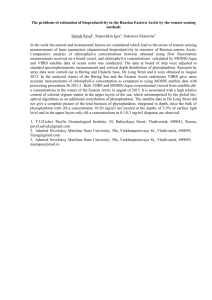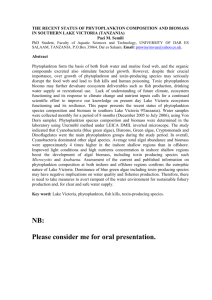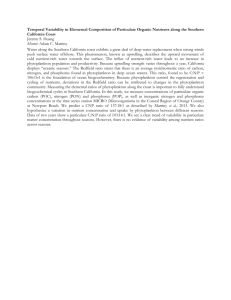Project Abstract
advertisement

Phytoplankton community composition, abundance, and health in the International Section of the St. Lawrence River Jessica Harold Advisor: Dr. Michael Twiss Clarkson Univeristy August 2, 2007 ABSTRACT Phytoplankton community composition, abundance, photosynthetic efficiency, and nutrients present in the water column were sampled on June 19-20 along a 178-km reach of the St. Lawrence River between Lake Ontario and the Moses-Saunders Dam in Massena, NY. A total of 19 sites spaced evenly along the transect were sampled. Phytoplankton community composition, photosynthetic efficiency, and total dissolved phosphorus did not vary significantly along the transect. Chlorophyll-a initially declined, indicating a decrease in phytoplankton abundance. Where the river was fully isothermal, chlorophyll-a started to steadily increase, but did not achieve a concentration as high as in Lake Ontario. It is hypothesized that predation by either zooplankton or benthic grazers are responsible for the decrease in phytoplankton abundance. The following increase in abundance may be due to the phytoplankton adapting to the more turbulent water and irregular light regime found in the St. Lawrence. Silicate concentrations increased from Lake Ontario to where the river became isothermal, approximately 114 km upstream of the Moses-Saunders Dam. This is likely due to the more turbulent river water stirring up the substrate. After the river became isothermal, the silicate concentrations leveled off. It is hypothesized that benthic diatoms are responsible for preventing the silicate concentrations from continuing to increase. INTRODUCTION The Great Lakes – St. Lawrence River system forms the second largest river network in North America in terms of annual discharge, and its basin holds approximately 18% of the world’s freshwater (Thorp et al. 2005). Surprisingly few studies have focused on the phytoplankton of this globally important watershed. The objective of this study is to measure the phytoplankton community composition and health in the International Section of the St. Lawrence River along a transect from Lake Ontario to the MosesSaunders Dam. Due to the wide variation among rivers, generalizations about the development of plankton along a river’s course are challenging (Basu et al. 2000). Past studies have shown that phytoplankton abundance can actually increase with downstream flow (Greenberg 1964, Talling and Rzoska 1967). However, research on the St. Lawrence River has found a decrease in biomass and average individual size of phytoplankton as well as changes in species composition with increasing distance from Lake Ontario (Thorp et al. 2005). Basu et al. (2000) noted that chlorophyll-a quickly declined as water flowed from Lake Ontario into the river. Interestingly, this trend may be reversed in fluvial lakes and tributaries. Phytoplankton communities below major tributaries are often taxonomically richer and of different compositions; ndividuals in fluvial lakes and below major tributaries may exhibit greater biomass, volume and chlorophyll-a content (Thorp et al. 2005). This occurrence has been noted on the St. Lawrence River below the Ottawa River, a major tributary. However Basu et al. (2000) found that fluvial lakes on the St. Lawrence River contribute only a small amount to downstream phytoplankton communities. Basu et al. (2000) also found that most phytoplankton production in fluvial lakes does not make its way into the main river channel, but remains in the lake. Based on past findings, it is hypothesized that phytoplankton biomass will decrease upon entry into the St. Lawrence River from the headwaters of Lake Ontario. There are three possible explanations to this phenomenon. The nutrients available to the phytoplankton may decrease as a result of the increased turbulence and therefore contact of nutrients with grazers on the sediment. Decreased nutrient availability would limit growth. Cell death may increase due to the turbulent regime either through disruption of phytoplankton physiology (Lewis et. al 1984) or increased predation on phytoplankton due to increased contact with dreissenid mussels, epi-benthic protozoa, and other grazers. A third possible explanation is cell loss from the water column due to increased flocculation (Ruiz et al. 2004). Due to the increased turbulence of the water in the St. Lawrence River, phytoplankton cells will come into contact with one another more often. This can result in flocculation (clumping) which may decrease buoyancy causing the phytoplankton involved to sink to the sediment or below the depth which allows them to photosynthesize. The flocculation may also increase predation by organisms such as zooplankton due to increased size and thus visibility. Basu and Pick (1997) found that there was no evidence of significant grazing by zooplankton in the Rideau River (Ontario, Canada average annual discharge 38.9m3s-1). This is supported by the finding that the biomass of zooplankton in rivers tends to be lower than in lakes (Basu and Pick 1996). It is also hypothesized that the phytoplankton community composition will change along the river transect due to changing environmental factors such as turbulence, nutrients, light regime and predation due to the unique needs of different types of phytoplankton. METHODS Study Area Nineteen fixed geo-referenced stations were sampled on June 19-20, 2007. The stations were numbered 1-20 from east to west. Station 19 was omitted due to poor weather conditions. The stations were approximately 8 kilometers apart and in deep water near the shipping channel so that the water sampled would be from Lake Ontario, and not influenced by tributaries/run-off. Odd or even stations were sampled on separate days to account for possible variations due to unique conditions on a given day. Figure 1: Map of the eastern end of Lake Ontario and the International Section of the St. Lawrence River. The red dots indicate stations 1 and 20. Field Sampling At each station, light, nutrients, and phytoplankton were investigated. All water samples were collected from a depth of 6 meters using a 2 liter Niskin bottle. Total Phosphorus and dissolved silica were sampled at every station. The total phosphorus analysis was performed in triplicate and the dissolved silica in duplicate. A light extinction coefficient was calculated at each station using a 4-π light sensor. Phytoplankton communities were assessed using a FluoroProbe profile with a unique water yellow substance calibration factor at each station A Fast Repetition Rate Fluorometer (FRRF) was used to determine the photosynthetic efficiency of whole phytoplankton samples. Size fractioned chlorophyll-a (microplankton >20 µm, nanoplankton (2-20 µm) and picoplankton (0.2-2 µm) were performed at each station by filtering water through different sized filters, placing the filters into acetone for extraction (Welschmeyer 1994), and using a fluorometer to determine concentrations of chlorophyll-a. Instruments The FluoroProbe (Series 7; bbe Moldeanke, GmbH) is a submersible probe that determines phytoplankton community composition by measuring photosynthetic pigment fluorescence at 5 wavelengths. The FluoroProbe determines the presence and abundance of four different communities, including Chlorophyta and Euglenophyta, PC rich Cyanobacteria, Heterokontophyta and Dinophyta, and PE rich Cyanobacteria and Cryptophyta. Chlorophyll-a concentration is determined by using a high energy excitation light and observing fluorescence, an emission light of lower energy. The FluoroProbe has a range of 0.1-200µg chlorophyll-a/L. At each station, the FluoroProbe was calibrated using a unique yellow substance correction. This task was accomplished by first rinsing the FluoroProbe in filtered river water(<0.45µm) then placing it into a pail with a clear food-grade polyethylene bag placed in a black opaque plastic bag contained in a rigid pail. 12-14L of filtered lake water were pumped from a depth of 0.3m through a 0.45µm pore size polyethersulfone cartridge filter (Groundwater Sampling Capsule, Millipore Corp., Bedford, MA) into the pail. Once in the pail, the FluoroProbe was covered with a black bag prior to calibration. This yellow substance correction was incorporated into the FluoroProbe software before the instrument was lowered into the water. After calibration the FluoroProbe was lowered slowly to either the substrate or a depth of 20 meters. Data from a depth of 6m ± 0.75m was used for this study because water samples were taken from a depth of 6m. The Fast Repitition Rate Fluorimeter (FRRF) (Mk1; Chelsea Instruments) measures the health of phytoplankton. This is accomplished be looking at the ratio of variable fluorescence to maximum fluorescence (Fv/Fm). The theoretical maximum level is 0.7. Fv is calculated by subtracting the base level fluorescence from the maximum fluorescence. Fv/Fm has shown strong diel periodicity in past studies in Lake Ontario. However, a diel study performed earlier in the summer did not exhibit any diel periodicity. It is not known at what point that periodicity is lost. To avoid any possible variability due to diel periodicity sampling was performed during daylight hours. Darkadapted and non dark-adapted samples from each station were used to determine if there was any difference between the two. The purpose of dark-adaption is to allow any phytoplankton within the sample to repair damage that has occurred to their bodies due to the sun. RESULTS No significant change was found in phytoplankton community composition along the river’s course (Figure 2). Chlorophyta and Euglenophyta were the most common types 100 90 80 70 60 50 40 30 20 10 0 %Cryptophyta and PE rich cyanobacteria %Heterokontophyta and Dinophyta % PC rich Cyanobacteria 179.0 152.1 132.9 95.9 114.6 77.3 58.3 39.2 21.4 % Chlorophyta and Euglenophyta 3.1 Percentage of Phytoplankton Division of phytoplankton present. Distance from the MosesSaunders Dam (km) Figure 2: Phytoplankton community composition along a 178 km transect of the St. Lawrence River: June 19-20, 2007 Phytoplankton community abundance did vary based on location (Figure 3). Concentration of Chlorophyll-a (µg/L) 2.50 2.00 Total (>0.22µm) 1.50 Micro (>20 µm) Nano (2-20µm) 1.00 Pico (0.22-2µm) 0.50 0.00 0.0 50.0 100.0 150.0 200.0 Distance from Moses-Saunders Dam (km) Figure 3: Extracted chlorophyll-a concentrations at 6m depth along a 178 km transect of the St. Lawrence River: June 19-20, 2007 Chlorophyll-a concentrations are highest just before the Moses-Saunders Dam and near Lake Ontario. There is a marked decrease in Chlorophyll-a concentrations in the middle region of the International Section of the St. Lawrence River. Along the length of the transect chlorophyll-a concentrations varied from 0.87 to 2.32 µg/L with a mean (± SE) of 1.52 ± 0.09µg/L. Data from the FRRF indicates that the health of the phytoplankton does not change significantly between Lake Ontario and the Moses Saunders Dam (Figure 4). This was determined due to the very low R2 values of regression lines for both dark- adapted and non-dark adapted samples. Additionally there was not a significant difference between dark-adapted and non dark-adapted water samples. 0.45 y = -0.0003x + 0.3579 R2 = 0.2074 Fv'/Fm' or Fv/Fm 0.40 0.35 0.30 Fv'/Fm' 0.25 Fv/Fm 0.20 Linear (Fv'/Fm') 0.15 Linear (Fv/Fm) 0.10 y = -0.0002x + 0.3612 R2 = 0.1005 0.05 0.00 0.0 50.0 100.0 150.0 200.0 Distance from the MosesSaunders Dam Figure 4: Fv/Fm and Fv’/Fm’ at a 6m depth along a 178 km transect of the St. Lawrence River: June 19-20, 2007. Fv/Fm are from dark-adapted samples and Fv’/Fm’ are from non-dark adapted samples. Dissolved silicate increased considerably from Lake Ontario until kilometer 114, which is indicated by the vertical red line in figure 5. 8.0 7.0 SiO2 (µM) 6.0 5.0 4.0 3.0 2.0 1.0 0.0 0.0 50.0 100.0 150.0 200.0 Distance from the Moses-Saunders Dam (km) Figure 5: SiO2 concentrations along a 178 km transect of the St. Lawrence River: June 19-20, 2007 At km 114 temperature data indicates that the river was completely isothermal (figure 6). Upstream of this point, SiO2 concentrations were approximately 5 µM. Downstream of this point SiO2 concentrations were just below 7µM. SiO2 concentrations ranged from 4.6 to 7.2 µM with a mean (± SE) of 6.2 ± 0.2 µM. 0 13º C 14º C 15º C 16º C 17º C 18º C Depth (m) 5 10 15 20 25 180 160 140 120 100 80 60 40 20 0 Distance upstream from Moses-Sauders Dam (km) Figure 6: Temperature values along a 178 km transect of the St. Lawrence River: June 19-20, 2007. Total dissolved phosphorus concentrations did not vary greatly along the transect. TP concentrations ranged from 31.9 to 45.7 nm and had a mean (± SE) of 36.3 ± 0.8 nm. There was no correlation found between chlorophyll-a and total dissolved phosphorus. Light extinction coefficients are an expression of the vertical attenuation of photosynthetically active radiation (PAR) downward in the water column (Kalff 2002). This extinction coefficient is due to the attenuation of water, suspended particles, chlorophyll-a, colored dissolved organic matter and colloidal organic matter (Kalff 2002). Higher values are due to higher levels of particulate matter within the lake water and thus a more rapid attenuation of PAR. The Kd for the transect had a mean (± SE) of 0.23 ± 0.01 and ranged from 0.12 to 0.35. These are typical Kd values for oligotrophic Light Extinction Coefficient (Kd) (nutrient-poor) lakes (Kalff 2002). 0.4 0.35 0.3 0.25 0.2 0.15 0.1 0.05 0 0.0 50.0 100.0 150.0 200.0 Distance from Moses-Saunders Dam (km) Figure 6: Light extinction coefficient along a 178 km transect of the St. Lawrence River: June 19-20, 2007 Discussion The phytoplankton community along the 180 km transect from Lake Ontario to the Moses-Saunders Dam is dominated by Chlorophyta (green algae) and Euglenophyta. This is an unusual finding, as both groups are typically abundant under eutrophic conditions (Kalff 2002). Phytoplankton abundance is initially high, decreases near the middle of the transect, and then increases. However, it does not attain the same high values that are found in Lake Ontario. This may be because they require more time to do so (phytoplankton abundance was still increasing at the Moses-Saunders Dam), or because of continued grazing. The health (photosynthetic ability) of the phytoplankton does not change along the river transect, indicating that cell death due to poor photosynthetic health is not the reason for the decreased abundance of phytoplankton. It is possible that these decreases are due to an increase in predation by zooplankton. The increased grazing could be a result of flocculation or an increased abundance of zooplankton. The decreases in phytoplankton abundance once the water column is isothermal may also be due to grazing by zebra mussels and other benthic grazers. Another possibility is that phytoplankton reproduce at a reduced rate when they first enter the river due to physiological disruption. Finally, it is possible that flocculation of phytoplankton causes cell loss from the water column because of an increase in density (Ruiz et al. 2004). The increasing abundance of phytoplankton observed in the second half of the transect may be due to several factors. There could be a reduction in benthic grazers and/or phytoplankton. It is also possible that the phytoplankton may adapt over time to their new environment, and be able to reproduce at a faster rate. The light extinction coefficients match up with chlorophyll-a abundance. When the abundance is high the Kd is low, and visa versa. This indicates that phytoplankton within the water column contribute to Kd values as they should (Kalff 2002) The lack of a correlation between chlorophyll-a and total dissolved phosphorus indicates that the availability of phosphorus is not a limiting factor in phytoplankton abundance. This is important to note because total phosphorus is typically the limiting nutrient in freshwater ecosystems. It is hypothesized that dissolved silicate concentrations increase due to the mixing of the water column as Lake Ontario moves into the St. Lawrence River and stratification is lost. This mixing is most noticeable around the point that is 114 km upstream of the Moses-Saunders Dam. When the water column mixes it stirs up the substrate and distributes silicate from the substrate throughout the water column. Silicate concentrations stop increasing ~20 km downstream of where the St. Lawrence River is completely isothermal. It is possible that benthic diatoms are partially responsible for leveling off silicate levels downstream of where the water column is isothermal. This study has collected baseline data on phytoplankton community composition, health, and abundance. It has also reported concentrations of two important nutrients: silicate and phosphorus. In addition it has ruled out a decline in nutrients and a decline in phytoplankton community health as the reason for an initial decrease in phytoplankton abundance as water first enters the St. Lawrence River from Lake Ontario. However, more research is called for to investigate hypothesis such as whether benthic diatoms are responsible for preventing a continued increase in silicate, and if zooplankton, benthic grazers, cell loss from the water column, disrupted phytoplankton physiology, or some other factor is responsible for the initial decrease in phytoplankton abundance. Basu, B.K., Klaff, J., Pinel-Alloul, B. 2000. Midsummer plankton development along a large temperate river: the St. Lawrence River. Can. J. Fish. Aquat. Sci. 57 (Suppl.1): 7-15. Basu, B.K., Pick, F.R. 1997. Phytoplankton and zooplankton development in a lowland temperate river. Journal of Plankton Research 19:237-253. Greenberg, A.E. 1964. Plankton of the Sacramento River. Ecology. 45:40-49. Kalff, Jacob. 2002. The Phytoplankton. In Limnology, p. 316. Upper Saddle River, New Jersey: Prentice Hall. Lewis, M. R., E. P. W. Horne, J. J. Cullen, N.S. Oakley & T. Platt. 1984. Turbulent motions may control phytoplankton photosynthesis in the upper ocean. Nature 311: 49-50; doi 10.1038/311049a0. Ruiz, J., Macias, D, Peters, F. 2004. Turbulence increases the average settling velocity of phytoplankton cells. Proc. Nat. Acad. Sci. 101:17720-17724. Talling, J.F., and Rzoska, J. 1967. The development of plankton in relation to hydrological regime in the Blue Nile. J. Ecol. 55:637-662. Thorp, J.H., Lamberti, G.A., and Casper, A.F. 2005. St. Lawrence River Basin. In Rivers of North America, eds. A.C. Benke and C.E. Cushing, pp. 983-1018. Boston: Elsevier Academic Press.







